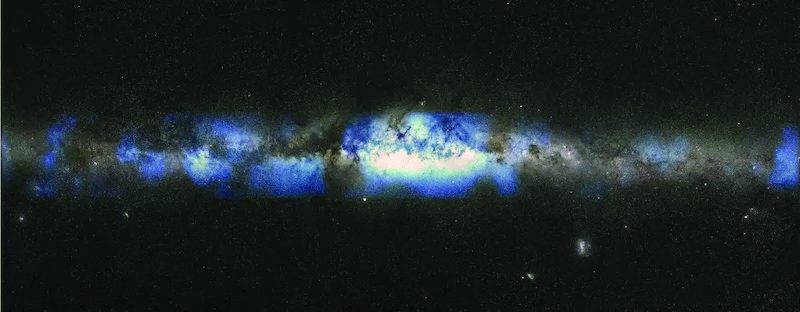First ever view of the Milky Way seen through the lens of neutrino particles

Oxford: Data collected by an observatory in Antarctica has produced our first view of the Milky Way galaxy through the lens of neutrino particles. It’s the first time we have seen our galaxy “painted” with a particle, rather than in different wavelengths of light.
The result, published in Science, provides researchers with a new window on the cosmos. The neutrinos are thought to be produced, in part, by high-energy, charged particles called cosmic rays colliding with other matter. Because of the limits of our detection equipment, there’s much we still don’t know about cosmic rays. Therefore, neutrinos are another way of studying them. It has been speculated since antiquity that the Milky Way we see arching across the night sky consists of stars like our Sun. In the 18th century, it was recognised to be a flattened slab of stars that we are viewing from within. It is only 100 years since we learnt that the Milky Way is in fact a galaxy, or “island universe”, one among a hundred billion others.
In 1923, the American astronomer Edwin Hubble identified a type of pulsating star called a “Cepheid variable” in what was then known as the Andromeda “nebula” (a giant cloud of dust and gas). Thanks to the prior work of Henrietta Swan Leavitt, this provided a measure of the distance from Earth to Andromeda.
This demonstrated that Andromeda is a far away galaxy like our own, settling a long-running debate and completely transforming our notion of our place in the universe.
Opening windows
Subsequently, as new astronomical windows have opened on to the sky, we have seen our galactic home in many different wavelengths of light - in radio waves, in various infrared bands, in X-rays and in gamma-rays. Now, we can see our cosmic abode in neutrino particles, which have very low mass and only interact very weakly with other matter hence their nickname of “ghost particles”.
Neutrinos are emitted from our galaxy when cosmic rays collide with interstellar matter. However, neutrinos are also produced by stars like the Sun, some exploding stars, or supernovas, and probably by most high-energy phenomena that we observe in the universe such as gamma-ray bursts and quasars. Hence, they can provide us an unprecedented view of highly energetic processes in our galaxy a view that we can’t get from using light alone.
The new breakthrough detection required a rather strange “telescope” that is buried several kilometres deep in the Antarctic ice cap, under the South Pole. The IceCube Neutrino Observatory uses a gigatonne of the ultra-transparent ice under huge pressures to detect a form of energy called Cherenkov radiation.
This faint radiation is emitted by charged particles, which, in ice, can travel faster than light (but not in a vacuum). The particles are created by incoming neutrinos, which come from cosmic ray collisions in the galaxy, hitting the atoms in the ice.
Cosmic rays are mainly proton particles (these make up the atomic nucleus along with neutrons), together with a few heavy nuclei and electrons. About a century ago, these were discovered to be raining down on the Earth uniformly from all directions. We do not yet definitively know all their sources, as their travel directions are scrambled by magnetic fields that exist in the space between stars. agencies



